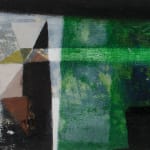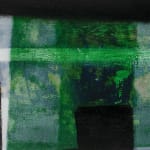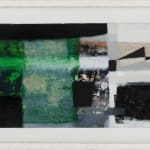
Land and Sea detail, John Wells, 1956.

Land and Sea, John Wells, in frame. 1956
John Wells 1907-2000
Framed: 29 x 89.8 cm (10.6 x 35 ins)
Further images
Provenance
Wilhelmina Barns-Graham's collection; one of 2 oils by John Wells that the artist owned.
The Wilhelmina Barns-Graham Foundation (Ref: WBG PR/COL/06)
The 1950s were a halcyon period for John Wells. The British Council of Fine Art invited the artist to exhibit in the San Paulo Biennial in the Festival of Britain year of 1951. Also, in 1951 Wells was one of only five St Ives artists invited to submit works to the 15th Annual Artists International Association Abstract Art exhibition in New York. This was the first time a British section had been included in the New York show, in fact the first significant showing of British Abstract painting in the USA, and Wells’ work hung alongside those of Hepworth, Nicholson, Lanyon, Frost and Barns-Graham as well as the titans of American Abstraction; Rothko, de Kooning and Motherwell. Following this successful introduction to the American market and collectors, Wells held one-man shows in the Durlacher Gallery in New York in 1952, 1958 and 1960. In 1958 the International Association of Art Critics awarded him the Critics’ Prize for ‘Vista’ (1955); one of the artist’s powerful Cornish landscape-inspired works of the mid-50s.
‘Vista’ was an example of a Wells’ painting of the mid-1950s that evoked a sense of movement over and in fact, through landscape. Another was Journey (1955), which depicts an actual journey to Bath Academy of Art.
Our work, ‘Land and Sea’ (1956), was the larger of two Wells’ paintings owned by Wilhelmina Barns-Graham, a close friend and associate of Wells. This painting appears to traverse and enter the West Cornwall landscape with evocations of sea and boats, a subterranean passage through landscape, cliffs, and perhaps even engine houses. The structure of the painting has a very distinct start, middle and end. In fact, it is quite possible to read the painting as tracing a north to south passage through West Penwith; from the ruggedness of the northern Heritage coast with its granite cliffs and mineral colours, cutting a subterranean path through the central moorland and ending up on the gentler coast and calmer sailing waters of the south where Wells was based. A horizontal band runs right across the 2.5 feet wide painting reinforcing the sense of movement through a landscape. This band of lighter tone has been created by Wells’ method of scraping back to reveal an earlier application of paint, and in places by a precise alignment of geometric forms and tonal variations.
Throughout his career Wells was drawn to places in Cornwall that allowed him to explore the forces of nature and in particular the relentless interaction between sea and land. In ‘Land and Sea’, curving brush-like incisions on the left of the painting create a sense of elemental forces; of wind and wave, resisted by a dark, rising, triangular form. A looser but similar suggestion of eroding forces and land’s resistance can be seen in ‘Cliff and Tide’ (1952).
As Martin Rowe observes in his excellent short biography on John Wells: “These (Wells’ landscapes of the 1950s) are products of Wells’ immense knowledge of his surroundings and their forms gained over time … However, they combine this with an interest in formal geometrical structure, subtle colour harmonies, a distilled study of natural forms and a painstaking technique to create a complex but ordered, constructed landscape”.







